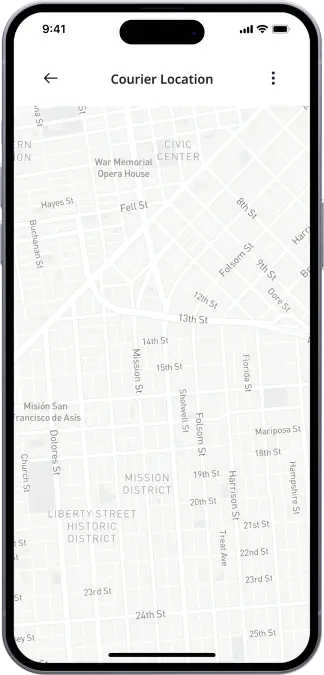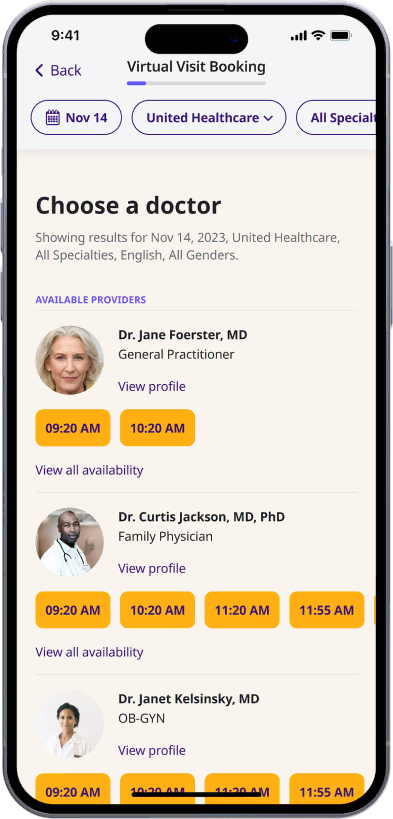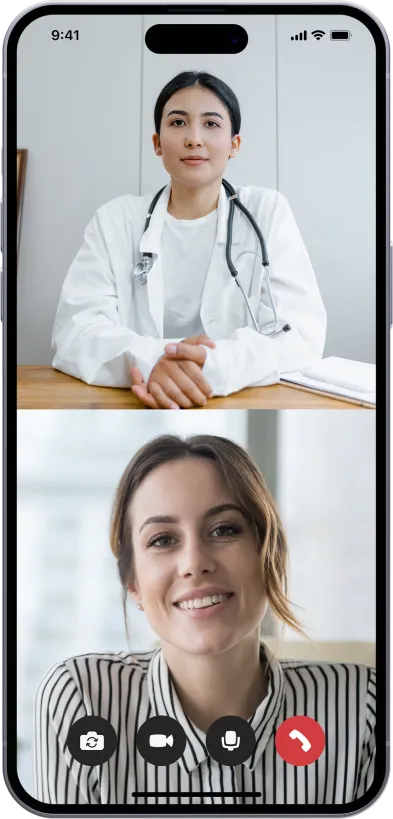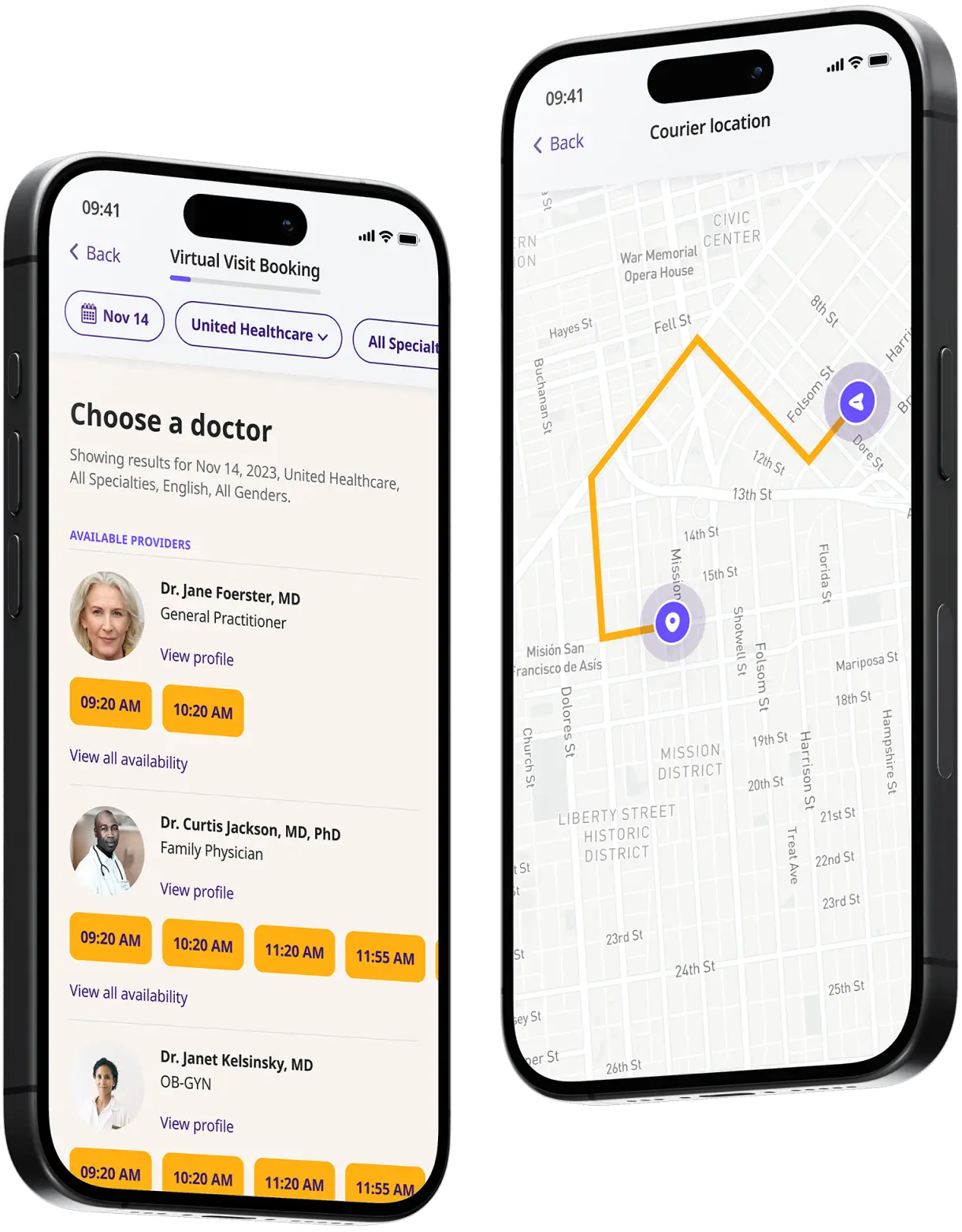Get a Cefaclor Prescription Online
Get a new Cefaclor prescription or refill your medication online.


Available in 50 states. Insurance accepted.
Fast
virtual visits
24/7 care
assistants
Prescriptions
as needed

24/7 Personal Care
Consult with a physician in 15 minutes, refill an Rx or chat with our care assistants.

Affordable & Convenient
See your cost upfront and get treatment for hundreds of different conditions.

Insurance Accepted
We accept most major insurance plans, making healthcare easy and affordable.
See If Delivery Is Available Near You
Delivery Not Available
Enter your ZIP code to check if prescription delivery is available in your area and how soon your meds could arrive.
How to get started
Choose your doctor, start a virtual visit, and have your prescriptions sent to your preferred pharmacy for pickup — all in just a few easy steps.
Choose a doctor
Choose a physician by availability, specialty, ratings, and more.

Start your video visit
Connect with a doctor in minutes on a secure video call.

Get your prescription
Pick up your meds or have them delivered in as little as an hour.

Available in 50 states. Insurance accepted.
One-Time
Physician Visit
One-time visit with a physician for diagnosis, treatment, Rx, labs, referrals, and doctor’s notes.
Accepted Insurances
See why people turn to DrHouse...
As seen in

Cefaclor (Generic Ceclor)
What is Cefaclor?
Cefaclor is an antibiotic medication used to treat bacterial infections. It belongs to the antibiotic class of cephalosporins, which also includes medications such as cephalexin and cefadroxil.
Cefaclor is available as a capsule, liquid suspension, and extended-release tablet. Its brand name is Ceclor.
Cefaclor is considered a broad-spectrum antibiotic, meaning it is able to treat a wide range of bacterial infections. This can make it an appealing treatment option when an illness can have multiple potential bacterial causes or if a doctor suspects more than one strain is causing your condition.
How Does Cefaclor Work?
Cefaclor works by impairing the bonds holding the bacterial cell wall together. The cell wall is the outside membrane of the bacteria, which maintains pressure within the bacteria’s cell. Cefaclor causes holes to appear in the cell walls, and as the holes build up, the pressure inside the cell builds until the membrane bursts, killing the bacteria.
What Is Cefaclor Used For?
Cefaclor is used to treat many bacterial infections, some of which include:
- skin infections
- bladder infections
- ear infections
- respiratory tract infections
- tonsillitis
- pneumonia
- cystitis
- pyelonephritis
- bronchitis
This list is incomplete, and cefaclor may be prescribed to treat infections not included.
Side Effects of Cefaclor
Common side effects of cefaclor include diarrhea and vaginal itching or discharge.
There are also some serious side effects of cefaclor, which include:
- fever
- joint pain
- swollen glands
- severe stomach pain
- bloody or water diarrhea
- jaundice
- seizures
If you experience any of these side effects, contact a medical professional.
Some people who take cefaclor may experience an allergic reaction, which has symptoms that can include numbness or tingling, hives, feeling light-headed, weakness, swelling of the lips, face, throat, or tongue, and difficulty breathing. If you exhibit any of these symptoms while taking cefaclor, seek immediate medical attention.
Cefaclor is not recommended for anyone allergic to it or similar antibiotics, such as cefprozil (Cefzil), cefdinir (Omnicef), cephalexin (Keflex), and cefuroxime (Ceftin), among others. Also, inform your doctor if you have an allergy to penicillin, a stomach or intestinal disorder, or kidney disease before taking cefaclor.
How to Take Cefaclor?
When taking any prescription medication, it is essential to follow all instructions provided by your doctor, including the dosage and dosing schedule. You should also continue taking cefaclor for the complete duration, even if you begin to feel better. Discontinuing cefaclor too soon increases the risk of a repeat infection or an even more severe illness.
The dosage of cefaclor prescribed by your doctor will depend on many factors, such as your age, the type and severity of your condition, and what other medical conditions you have.
Cefaclor can be taken with or without food. If you experience an upset stomach while taking cefaclor, taking it with food, or within 30 minutes of eating, may help ease these symptoms.
For those taking the extended-release tablet, do not crush, break, or chew it—swallow the tablet whole. Those taking the capsule can open it, but if you do so, you must mix the contents with a liquid or applesauce and take the mixture right away.
The tablets and capsules should be stored at room temperature and away from heat and moisture. As for the liquid suspension, store it in the refrigerator and dispose of any medication that has not been used within 14 days.
If you miss a dose of cefaclor, take the missed dose as soon as you remember. However, if it is almost time for your next dose, skip the missed dose. Do not take two doses at once to make up for a missed dose as it is possible to overdose on cefaclor, with symptoms that include vomiting, nausea, diarrhea, and stomach pain. If you think you have overdosed, contact your doctor.
Frequently Asked Questions About Cefaclor
What Should You Avoid While Taking Cefaclor?
Cefaclor can interact with other medications, vitamins, and supplements. Because of this, telling your doctor about everything you are taking is important.
Taking cefaclor with medications such as warfarin and other blood thinners can increase your risk of side effects from the drugs. For example, with warfarin, taking it alongside cefaclor can increase your risk of bleeding.
Taking cefaclor with certain medications can also increase the risk of side effects from cefaclor. For example, taking probenecid with cefaclor can increase your risk of stomach problems.
Excessive or regular consumption of alcohol could also increase the risk of side effects or interfere with the efficacy of Cefaclor.
The mentioned things above are simply some of the potential interactions to watch out for and there may be other medications or substances that could interact negatively with this medication.
Be sure to discuss any and all medications, vitamins, and supplements with your doctor before taking cefaclor.
What Is the Most Common Side Effect of Cefaclor?
The most common side effect of cefaclor is diarrhea. This can range from mild to severe, so if you experience any discomfort it is recommended that you speak with your doctor or pharmacist about your condition. Other common side effects include:
- Vomiting
- Abdominal pain
- Rashes
What Is the Typical Dosage for Cefaclor?
The exact dosage of cefaclor will depend on various factors, such as the type and severity of your infection, your age, the specific formulation of cefaclor used, and any other medical conditions you may have.
You should speak with your healthcare provider for specific dosing instructions based on your individual needs.
Can You Get Cefaclor Over-The-Counter (OTC)?
No, cefaclor is not available over-the-counter. It’s only available with a prescription from a licensed healthcare provider.
Can I Get Cefaclor Online?
Yes, you can receive an online prescription for cefaclor through DrHouse. Our licensed physicians can conduct virtual consultations and prescribe cefaclor if deemed appropriate after reviewing your medical history and current condition.
For more detailed information about Cefaclor, you can refer to the following sources:
- Cefaclor prescription label, Food and Drug Administration (FDA).
- Cefaclor, Drugs.com.
- Cefaclor, MedlinePlus.
The content on this page has been medically reviewed for accuracy and comprehensiveness by Amy Dougherty, FNP-BC, AGAC
Related services
Explore more of our services tailored to your needs and discover additional ways we can support your healthcare needs.
Frequently asked questions




